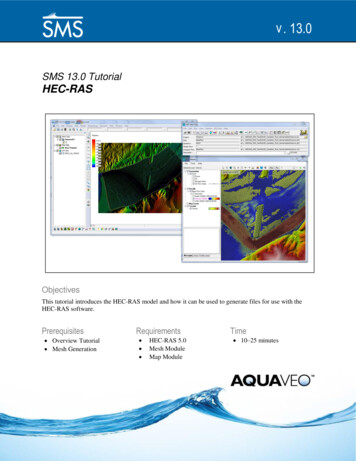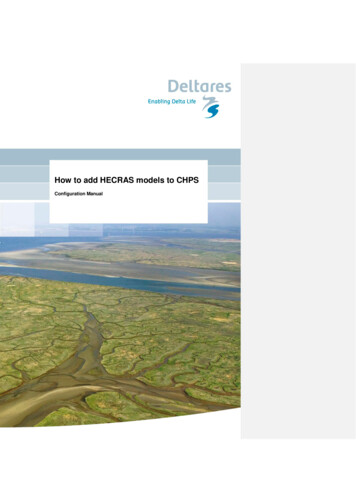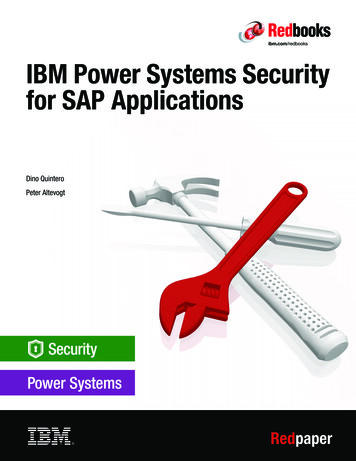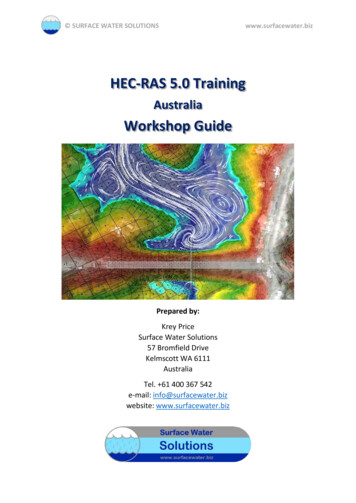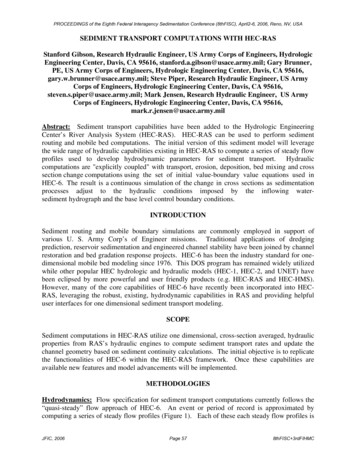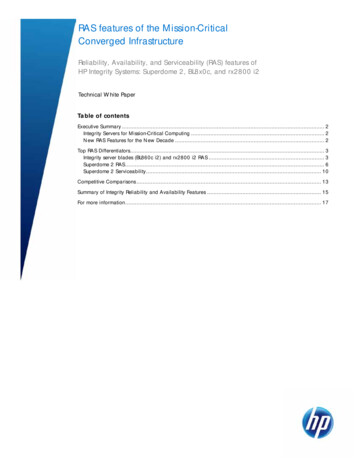
Transcription
RAS features of the Mission-CriticalConverged InfrastructureReliability, Availability, and Serviceability (RAS) features ofHP Integrity Systems: Superdome 2, BL8x0c, and rx2800 i2Technical White PaperTable of contentsExecutive Summary . 2Integrity Servers for Mission-Critical Computing . 2New RAS Features for the New Decade . 2Top RAS Differentiators. 3Integrity server blades (BL860c i2) and rx2800 i2 RAS . 3Superdome 2 RAS . 6Superdome 2 Serviceability . 10Competitive Comparisons . 13Summary of Integrity Reliability and Availability Features . 15For more information . 17
Executive SummaryIntegrity Servers for Mission-Critical ComputingHP Integrity Servers have been leaders in the industry for providing mission-critical RAS since theirinception. This latest generation of Integrity, based on HP’s Converged Infrastructure, not only offerscommon infrastructure, components, and management from x86 to Superdome, but also extends theIntegrity RAS legacy. The new line of HP Integrity servers consists of the BL860c i2, BL870c i2,BL890c i2 server blades; the rx2800 i2 rack-mount Integrity server; and the Integrity Superdome 2.All of these latest generation of Integrity servers are designed to maximize uptime and reduceoperating costs.HP’s latest generation of Integrity Servers are all part of HP’s Converged Infrastructure. This meansthat all of HP’s servers from x86 to Superdome use the same racks, enclosures, and managementenvironments, thus allowing HP to focus on the value-add mission-critical RAS features of Integrity.Hot-swap n 1 redundancy for fans and power supplies; and single-bit detect and double-bit correcterror correction coding with single chip kill for memory are examples of industry-wide standard serverRAS features. Though the new Integrity systems have these too, this white paper will instead focus onthe differentiating RAS features that set them above the industry standard servers.New RAS Features for the New DecadeHP uses Intel’s most reliable processor, the Itanium processor 9300 series (Tukwila-MC) to drive itsmission critical line of Integrity servers. The Itanium processor 9300 series is packed with over onebillion transistors in the most reliable, four-core processor technology. Some of the RAS features of theItanium processor 9300 series include multiple levels of error correction code (ECC), parity checking,and Intel Cache Safe Technology.With Blade Link technology, the Integrity server blades provide mission-critical level RAS in a costeffective, scalable blade form factor, from one to eight processor sockets.For higher processor socket counts, larger memory footprints, greater I/O configurations, ormainframe-level RAS; Superdome 2 is the platform of preference. To provide the tremendous scalingand performance; Superdome 2 uses the new HP sx3000 custom chip set that ultimately gives 4.5xbetter fabric availability than legacy Superdome servers.At the platform level, HP further enhances the hardware with more RAS features including HP’smission-critical operating systems: HP-UX and OpenVMS. Because HP has full control of the entireRAS solution stack, these operating systems integrate tightly with the server hardware to provideproactive system health monitoring, self-healing, and recovery beyond what the hardware alone cando. But what about non-proprietary operating systems such as Windows? Can HP still provide betterserviceability features when using an industry standard operating system? The Superdome 2 doeswith its newly introduced Superdome 2 Analysis Engine.The Analysis Engine takes the proactive RAS monitoring and predictive abilities of the HPmission-critical operating systems and packages it in firmware that runs within the hardware,no operating system required! And because it is always on, all the time, the Analysis Engine iscomprehensively more accurate at diagnosing problems in the making.2
Top RAS DifferentiatorsIntegrity server blades (BL860c i2) and rx2800 i2 RASThe Integrity server blades have up to two times the reliability of comparably configured industrystandard volume systems. Integrity servers provide mission-critical resiliency and accelerate businessperformance. Higher RAS is provided in all key areas of the architecture.The key differentiating RAS features on the Integrity server blades and the rx2800 i2 are: Double-Chip Memory Sparing Dynamic Processor Resiliency Enhanced MCA Recovery Processor Hardened latches Intel Cache Safe Technology QPI & SMI error recovery features (point-to-point & self-healing) Passive backplaneFigure 1 shows the basic two-processor socket, building block of the rx2800 i2 rack-mount and theBL860c i2 server blade architectures. The two-socket blade building blocks are conjoined in pairs tomake the four-socket BL870c i2; and are conjoined in multiples of four to make the eight-socketBL890c i2.Figure 1: BL860c i2 and rx2800 i2 Platform RAS17x better reliability thanSingle-Chip SparingMBMBItanium 9300(Tukwila-MC)MBMBMBMBMBMBMemory RAS Double-Chip Sparing Pro-active memory scrubbing Addr/Ctrl Parity checkingDDR3 DIMM DDR3 DIMMDDR3 DIMM DDR3 DIMMDDR3 DIMM DDR3 DIMMDDR3 DIMM DDR3 DIMMDDR3 DIMM DDR3 DIMMDDR3 DIMM DDR3 DIMMDDR3 DIMM DDR3 DIMMDDR3 DIMM DDR3 DIMMDDR3 DIMM DDR3 DIMMDDR3 DIMM DDR3 DIMMDDR3 DIMM DDR3 DIMMDDR3 DIMM DDR3 DIMMItanium 9300(Tukwila-MC)Intel 7500IOH(Boxboro-MC) PCIe LCRC Soft Error hardened latches Cache Safe technology for L2I,L2D, Directory, L3 Recoverable MCAIntel ICH10 Lane failoverIO RAS PCIe AdvancedError ReportingProcessor RAS ECC, parity protection Correctable Machine CheckInterrupt (CMCI)QPISMI RAS Retry on CRC error2x better reliability thanindustry volume CPUsQPI RAS Link recovery on CRC errorPCIe Gen2Gen1PCIe CardsCore I/O Self-healing by mapping out baddata/clock lanes Poison forwarding3
Double-Chip Memory SparingThe industry standard for memory protection is 1-bit correction and 2-bit detection (ECC) of dataerrors. Furthermore, virtually all servers on the market provide Single-Chip Sparing also known asAdvanced ECC and Chip-kill. These protect the system from any single-bit data errors within amemory word; whether they originate from a transient event such as a radiation strike, or frompersistent errors such as a bad dynamic random access memory (DRAM) device. However, SingleChip Sparing will generally not protect the system from double-bit faults. Though detected, these willcause a system to crash.In order to better protect memory, many systems including Integrity servers implement a memoryscrubber. The memory scrubber actively parses through memory looking for errors. When an error isdiscovered, the scrubber rewrites the correct data back into memory. Thus scrubbing combined withECC prevents multiple-bit, transient errors from accumulating. However, if the error is persistent thenthe memory is still at risk for multiple-bit errors.Double-Chip Sparing in Integrity servers addresses this problem. First implemented in the HP zx2 andsx2000 custom chipsets of the prior generation of Integrity servers, this capability has been movedinto the Itanium 9300 processors along with the memory controllers. Double-Chip Sparing (or DoubleDevice Data Correction (DDDC)) technology determines when the first DRAM in a rank has failed,corrects the data and maps that DRAM out of use by moving its data to spare bits in the rank. Oncethis is done, Single-Chip Sparing is still available for the corrected rank. Thus, a total of two entireDRAMs in a rank of dual in-line memory modules (DIMMs) can fail and the memory is still protectedwith ECC. Due to the size of ranks in Integrity, this amounts to the system essentially being tolerant ofa DRAM failure on every DIMM and still maintaining ECC protection. Note that Double-Chip Sparingrequires x4 DIMMs to be used (currently all DIMMs 4 GB or larger). If a x8 DIMM is used (currently 2GB only), the systems default to Single-Chip Sparing mode.Figure 2: Improvement to Reliability with Double-Chip SparingExample system: Annual field replaceable unit repair rates16 Double-ChipSparing DIMMs5 Small PCA Boards14 Cables & 2 PowerCordsDVD R/RW DriveSCSI Disk BackplaneCore I/O Board withVGA, LAN, etc.Memory ControllerBoardMother (Processor)Board4 Itanium ProcessorAssembliesI/O Backplane2 Power Supplies16 Single-ChipSparing DIMMs4 System Fans4 PCI-X I/O Cards4 SCSI Hard Disks17x Memory Repair Rate Improvementwith Double-Chip SparingThis maximizes the coverage of HP’s unique protection mechanism without degrading performance.Unlike memory mirroring, DIMM spares, and RAID memory; no extra DIMMs are required forDouble-Chip Sparing. It more efficiently uses the same DRAMs used for Single-Chip Sparing.4
Double-Chip Sparing drastically improves system uptime, as fewer failed DIMMs need to be replaced.As shown in Figure 2, this technology will deliver about a 17x improvement in the number of DIMMreplacements versus those systems that use only Single-Chip Sparing technologies. Furthermore, withrepair rates on DIMMs lowered to be on the order of cables, the top four failing field replaceableunits (FRUs) are all hot-swappable (Disks, IO cards, Fans, and power supplies) in a four processorentry-level Integrity system.Furthermore, Double-Chip Sparing in Integrity servers reduces memory related crashes to be one thirdthat of systems that have Single-Chip Sparing capabilities only.Intel Cache Safe TechnologyThe majority of processor errors are bit flips in the processor local memory, known as the cache.These cache errors are similar to DRAM DIMM errors in that they can be either transient or persistent.Itanium processors implement ECC in most layers of the cache, and parity checking in layers thathave copies of data from ECC protected layers. Thus, all levels of the cache are protected from anysingle-bit problem.To improve on ECC, Itanium implements a more advanced feature known as Intel Cache SafeTechnology. To keep a multi-bit error from occurring, the system determines if the failed cache bit ispersistent or transient. When the error is persistent, the data is moved out of that cache location andput in a spare. The bad cache location is permanently removed from use and the system continues on.Thus with the combination of ECC and Intel Cache Safe Technology, the cache is protected from mostmulti-bit errors.Processor Soft Error (SE) Hardened Latches and RegistersOne of the most common sources of naturally occurring transient computer errors is high-energyparticles striking the nuclei in electrical circuits. There are two common sources for high-energyparticles. The first comes in the form of alpha particles released from radioactive contamination ofmaterials used in circuits. The second is high-energy neutrons that get launched when solar radiationionizes molecules in the upper atmosphere. Alpha particles can be minimized through stringentmanufacturing processes, but high energy neutron strikes cannot be.Such particle strikes can cause the logic to switch states. DRAMs on DIMMs and the memory cachesof the processor have ECC algorithms and correction mechanisms to recover from such randomoccurrences. But what is done to protect the core of the CPU?The Intel Itanium processor 9300 series includes new circuit topologies that dramatically reduce thesusceptibility of the core latches and registers to such particle strikes. Estimates show that the soft errorhardened latches reduce soft errors by about 100x, and the soft error hardened registers reduce softerrors by about 80x.Dynamic Processor ResiliencyThe flagship processor RAS feature for Integrity servers is HP’s Dynamic Processor Resiliency (DPR).DPR is a set of error monitors that will flag a processor as degraded when it has experienced acertain number of correctable errors over a specific time period. These thresholds help identifyprocessor modules which are likely to cause uncorrectable errors in the future that can panic the OSand bring the system or partition down. DPR effectively “idles” these suspect CPUs (deallocate), andmarks those CPUs to not be used (deconfigured) on the next reboot cycle.Dynamic Processor Resiliency has continued to be enhanced with each generation of Integrity serverto deal with new recoverable error sources, such as register parity errors. These further differentiateIntegrity servers from the competition.5
The new Itanium processor 9300 series provides 2x better reliability than industry volume processorsby utilizing features such as: Intel Cache Safe Technology , error hardened latches, register storeengine, memory protection keys, double device data correction, and CPU sparing and migration.In addition, Itanium’s Enhanced Machine Check Architecture (MCA) and MCA recovery allow theHP-UX operating system to recover from errors that would cause crashes on other systems.Enhanced MCA RecoveryEnhanced MCA Recovery is a technology that is a combination of processor, firmware, and operatingsystem features. The technology allows for errors that can’t be corrected within the hardware alone tobe optionally recovered from by the operating system. Without MCA recovery, the system would beforced into a crash. However, with MCA recovery the operating system examines the error,determines if it is contained to an application, a thread, an OS instance or not. The OS thendetermines how it wants to react to that error.When certain uncorrectable errors are detected, the processor interrupts the OS or virtual machineand passes the address of the error to it. The OS resets the error condition and marks the defectivelocation as bad so it will not be used again and continues operation.QPI & SMI error recovery features (point-to-point & self-healing)Both QuickPath Interconnect (QPI) and Scalable Memory Interconnect (SMI) have extensive cyclicredundancy checks (CRCs) to correct data communication errors on the respective busses. They alsohave mechanisms that allow for continued operation through a hard failure such as a failed lane orclock.With SMI lane fail-over, the SMI uses a spare lane to fail-over a bad one due to persistent errors. Thisis done automatically by the processor and the memory controllers for uninterrupted operation with noloss in performance.With QPI self-healing, full-width QPI lanes will automatically be reduced to half-width when persistenterrors are recognized on the QPI bus. Similarly half-width ports will be reduced to quarter-width.Though there is a loss in bandwidth, overall operation can continue. SMI lane fail-over and QPI selfhealing thus prevent persistent errors from eventually crashing the system. Furthermore in some cases,continually correcting persistent errors can affect performance more than self-healing techniques thatreduce the band-width.Superdome 2 RASIn addition to the RAS features found in the Integrity server blades, Superdome 2 has numerousinnovative self-healing, error detection, and error correction features to provide the highest levels ofreliability and availability. New hardware features contribute to the increased reliability of theSuperdome 2 infrastructure. The key differentiating Superdome 2 RAS features are: Electrically isolated hard partitions (nPartitions) Fault Tolerant Fabric Superdome 2 Analysis Engine Fully redundant, hot-swap system clock tree Custom PCIe Gen2 IOH with Advanced I/O RAS features C7000 enclosure-like serviceability of major components and FRUs6
MBMBMBMezz CardsXFMXBARI/O ExpansionPCIe Gen2x8 PCI-EL4 CacheXFM Link width reduction End-to-end retry Fully redundant parts and paths Hot-swap XBARsBlade RAS nPartitions Hot-swap n 1 clocks4.5x Better InfrastructureAvailability than SD1x8 PCI-Ex8 PCI-Ex8 PCI-Ex8 PCI-Ex8 PCI-Ex8 PCI-Ex8 PCI-EXBARHP Fault-Tolerant Fabric RAS Packet-based transport layer tracks receiptof packets across fabricx8 PCI-Ex8 PCI-EXFMXBARx8 PCI-Ex8 PCI-Esx3000 IOHMBPCIe Gen2sx3000AgentQPIMBXBARsx3000 IOHMBsx3000AgentMBXFMItanium 9300(Tukwila-MC)MBFabricsx3000 IOHBladeL4 CacheItanium 9300(Tukwila-MC)DDR3 DIMMDDR3 DIMMDDR3 DIMMDDR3 DIMMDDR3 DIMMDDR3 DIMMDDR3 DIMMDDR3 DIMMDDR3 DIMMDDR3 DIMMDDR3 DIMMDDR3 DIMMDDR3 DIMMDDR3 DIMMDDR3 DIMMDDR3 DIMMDDR3 DIMMDDR3 DIMMDDR3 DIMMDDR3 DIMMDDR3 DIMMDDR3 DIMMDDR3 DIMMDDR3 DIMMDDR3 DIMMDDR3 DIMMDDR3 DIMMDDR3 DIMMDDR3 DIMMDDR3 DIMMDDR3 DIMMDDR3 DIMMFigure 3: Superdome 2 Blade Platform RASHP Custom IOH RASwith PCIe Gen2 Enhanced I/O ErrorHandling & Recovery LCRC & eCRCSuperdome 2 Availability OverviewAvailability is the ability of a system to do useful work at an adequate level despite failures, patches,and other events. One method of obtaining high availability is to provide methods to add, replace orremove components while the system is running. All of the components that can be serviced live in thec-Class systems can also be physically removed and replaced while partitions continue to run inSuperdome 2. In addition, the unique Superdome 2 components including the Crossbar FabricModules (XFMs) and Global Partitions Service Modules (GPSMs) are on-line serviceable. The sx3000chipset, firmware, and OS provide the capability to add, replace or delete blades, XFMs, and I/Ocards in the IOX while the application is running. Blade OLRAD supports workload balancing,capacity on demand, power management, and field service.Electrically Isolated Hard PartitionsResiliency is a prerequisite for true hard partitions. Each hard partition has its own independent CPUs,memory, and I/O resources consisting of resources of the blades that make up the partition.Resources may be removed from one partition and added to another by using commands that arepart of the System Management interface, without having to physically manipulate the hardware.With a future release of HP-UX 11i, using the related capabilities of dynamic reconfiguration(e.g. on-line addition, on-line removal), new resources may be added to a partition and failedmodules may be removed and replaced while the partition continues in operation.7
Figure 4: Hard partition error containmentScalable Partition 2Blade 1Blade 2IOBlade 1Blade 3IOCrossbarFabricHW FirewallBlade 3Shared Backplane BusBlade 4IOPartition 1nPartition architectureOn the HP system, the crossbar logicallyseparates the two physical partitions toprovide performance and isolation.More Reliable,More ScaleableBlade 2Partition 2Blade 4Partition 2Other architecturesA shared backplane has all its bladescompeting for the same electrical busresulting in many shared failure modes.The high queuing delays and saturationof the shared backplane bus can alsolimit performance scaling.Crossbar (XBAR) Fault ResiliencyThe system crossbar provides unprecedented containment between partitions, along with highreliability for single partition systems. This is done by providing high-grade parts for the crossbarchipset, hot-swap redundant crossbar replaceable units (XFMs), and fault-tolerant communicationpaths between HP Integrity Superdome 2 blades and I/O. Furthermore, unlike other systems withpartitioning, HP provides specific hardware dedicated to guarding partitions from errant transactionsgenerated on failing partitions.Fault-Tolerant FabricSuperdome 2 with the sx3000 chipset implements the industry’s, best-in-class, fault tolerant fabric. Thebasics of the fabric are redundant links and a packet-based transport layer that guarantees delivery ofpackets through the fabric.The physical links themselves contain availability features such as link width reduction that essentiallyallow individual wires or I/O pads on devices to fail and the links are reconfigured to eliminate thatbad wire. Strong CRCs are used to guarantee data integrity.Beyond the reliability of the links themselves, the next stage of defense is end-to-end retry. When apacket gets transported, the receiver of the packet is required to send acknowledgement back to thetransmitter. If there is no acknowledgement, the packet is retransmitted over a different path to thereceiver. Thus end-to-end retry guarantees reliable communication for any disruption or failure in thecommunication path including bad cables and chips.When combined with the hot-swappable crossbars, end-to-end retry and link width reductionresults in a Superdome 2 fabric that is 4.5x more reliable than the already impressive legacySuperdome fabric.8
Clock RedundancyThe fully redundant clock distribution circuit contains the clock source and continues through thedistribution to the blade itself. All mid-planes of Superdome 2 are completely passive, unlike legacySuperdome where the crossbar switches are integrated onto the mid-plane.The system clocks are powered by 2 fully redundant and hot-pluggable Hardware ReferenceOscillators (HSOs) which support automatic, “glitch-free” fail-over/reconfiguration and are hotpluggable under all system operating conditions.During normal operation, the system selects one of the two HSOs as the source of clocks for theplatform. Which one gets selected depends whether the oscillator is plugged into the backplane andon whether it has a valid output level. If only one HSO is plugged in and its output is of validamplitude then it gets selected. If both HSOs are plugged in their output amplitudes that are valid thenone of the two is selected as the clock source by logic on the MHW FPGA.Figure 5: Clock redundancyHot-SwapUtility )Hot-SwapUtility )SD Blade 0Clk - 0Clk - 1Redundantclockdistributionacrosspassivemid-plane tobladesDynamicClock SwitchConfigurationControl InputsBladeclocksStatus OutputsMHWFPGAClk - 0Clk - 1X8SD Blade 8Hot-SwapXFMClockBufferCore clkHot-SwapXFMClockBufferCore clkHSS clkXBARX4HSS clkXBARMargin clock selectIf one of the HSOs outputs fails to have the correct amplitude then the RCS will use the good one asthe source of clocks and send and alarm signal to the system indicating which HSO failed. The greenLED will be lit on the good HSO and the yellow LED will be lit on the failed HSO. This clock sourcecan then be repaired through a hot-plug operation.9
Isolated I/O PathsThis feature allows accessibility to a storage-device/networking-end-node through multiple paths. Theaccess can be simultaneous (in an active-active configuration) or streamlined (in an active-passiveconfiguration). With this feature, points of failure between two end points can be eliminated. Thesystem software can automatically detect network/storage link failures and can failover (online) to astandby link. This feature makes the system fault tolerant to any I/O cable, crossbars (XBAR), anddevice-side I/O card errors, which are estimated to be at least 90% of all I/O error sources.Advanced I/O Error Handling and RecoveryThe PCI Error Handling feature allows an HP-UX system to avoid a Machine Check Abort (MCA) or aHigh Priority Machine Check (HPMC), if a PCIe error occurs (for example, a parity error). Without thePCI Error Handling feature installed, the PCIe slots are set in hard-fail mode. If a PCIe error occurswhen a slot is in hard-fail mode, an MCA will occur, and then the system will crash.With Advanced I/O Error Handling, the PCIe cards will be set in soft-fail mode. If a PCIe error occurswhen a slot is in soft-fail mode, the slot will be isolated from further I/O, the corresponding devicedriver will report the error, and the driver will be suspended. The OLRAD command and the AttentionButton can be used to online recover, restoring the slot, card, and driver to a usable state. PCIadvanced error handling, coupled with Multi-pathing, is expected to remove upwards of 90% of I/Oerror causes from system downtime.PCIe Hot-Swap or OL* (Online addition, replacement, and deletion)The system hardware uses per-slot power control combined with operating system support for the PCIeCard online addition (OLA) feature to allow the addition of a new card without affecting othercomponents or requiring a reboot. This feature enhances the overall high availability solution forcustomers since the system can remain active while an I/O adapter is being added. All HP supportedPCIe cards (Gigabit Ethernet, Fiber Channel, SCSI, Term I/O, etc.) and the corresponding drivershave this feature. The new card added can be configured online and quickly made available to theoperating environment and applications. PCI OL* is an easy to use feature in HP products, enhancedby the inclusion of doorbells and latches.Furthermore, I/O cards can fail over time, resulting in an automatic failover to the secondary path, ora loss of a connection to a non-critical device (For those devices that do not warrant dual-path I/O).PCI online replacement (OLR) allows a user to repair a failed I/O card, online, restoring the system toits initial state without incurring any customer visible downtime.The Advanced PCIe I/O RAS features are unique to Integrity systems and are enhanced by HP’smission-critical operating systems like HP-UX and OpenVMS. The combination of these features resultin 20x to 25x better availability of the I/O subsystem.Superdome 2 ServiceabilitySuperdome 2 has been designed to be highly serviceable. Many components have been leveragedfrom the c-Class and the new ones have been designed to the same service standards. Service repairscan be done quickly and efficiently usually with no tools.10
Figure 6: Superdome 2 ComponentsRear viewFront view12 c-7000power suppliesSlim DVD Drive8 SD2Blades2 c-7000input powermodules4 XFMs8 interconnectmodules15 c-7000Fans2 OAsc-7000 Insight DisplayAll components front and rear accessible for easy serviceabilitySuperdome 2 Analysis EngineThe Classic Health Monitoring ModelHP Server platforms use management processors such as Integrated Lights-Out 3 (iLO 3) to monitorfundamental hardware health such as voltage, temperature, power, and fans. In this classic design,the management processor signals software agents running on the OS when it detects a problem thatneeds an administrator’s attention. These server health agents then alert the administrator throughprotocols such as IPMI, SNMP, or WEBM. This classic picture works very well for small servers andthose without partitions, such as the Integrity BL860c i2 and rx2800 i2.The Legacy Superdome Health Monitoring ModelHP extended the classic model and applied it to the previous generation of sx1000- and sx2000based Superdome servers. In these systems, there is a set of management processors, monitoring theshared system hardware. In addition, there are separate components monitoring the partition-specifichardware.Because these servers contain multiple OS-partitions, every OS-partition is notified when amanagement processor detects a problem in shared hardware. For example, if a power supply fails,every OS-partition is notified. Consequently, every OS-partition sends an alert and the administrator isinundated with redundant error messages.Conversely, problems found only on a single partition’s hardware are not shared with monitoringcomponents in other partitions or with the main management processor. Thus administrators mustcheck multiple, separate health logs for complete system information.11
Figure 7: Superdome 2 Analysis EngineManagement alerts!HP SIM &HP Remote Support!!?OSOS agents!!!OSOS agentsOnboardAdministratorGUI and CLIPartition & F/W ManagementAnalysisEngineAEOAError Logging ServicesCore Analysis EngineHealth ViewersOSOS agentsHardware iLOHealth Repositorysx3000 mgmtPartitionHardwareShared LOiLO iLOHardware iLO iLOHardwareOS“Classic” OS-basedplatform managementSuperdome sx1000, sx2000 One OS, sees all thehardware Each OS sees only a portion of thesystem System is small, errorsare fairly easy to findand repair Every OS partition generates alerts,causing multiple duplicate report System is large, multiple logs must bechecked and cleared Harder to diagnose, longer time to repairSelf RepairShared HardwareSuperdome 2OSAgentlesshealth check OA: One access point to whole system Built-in System Analysis initiates self-repair Agentless core platform health check Duplication is eliminated -one log, one report Errors located with pinpoint accuracy, FRUrepair is tracked by serial numberThe Superdome 2 Health Monitoring Model—The Analysis EngineIn Superdome 2, the core platform OS agents have been removed and replaced with analysis toolsthat run in the management processor subsystem. Administrative alerts come directly from theSuperdome 2 Analysis Engine, not from each OS partition, thus eliminating duplicate reports.The Analysis Engine does much more than just generate alerts. It centrally collects and correlates allhealth data into one report. It then analyzes the data and can automatically initiate a self-repairwithout any operator intervention.Since the Analysis Engine is a part of the firmware, error handling rules are updated only in onelocation. It is available with or without on-line OS-diagnostics and errors can be analyze
Integrity Servers for Mission-Critical Computing HP Integrity Servers have been leaders in the industry for providing mission-critical RAS since their inception. This latest generation of Integrity, based on HP's Converged Infrastructure, not only offers common infrastructure, components, and management from x86 to Superdome, but also extends the



